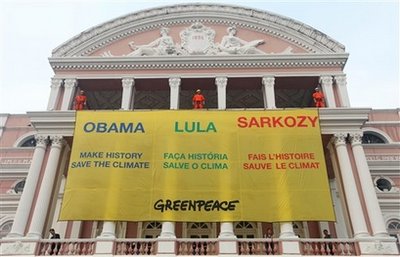America
New climate targets may not change daily life much
(Agencies)
Updated: 2009-11-27 16:20
WASHINGTON: Americans' day-to-day lives won't change noticeably if President Barack Obama achieves his newly announced goal of slashing carbon dioxide pollution by one-sixth in the next decade, experts say.
Except for rising energy bills. And how much they'll go up depends on who's doing the calculating.
|
|
The White House will commit the US to a goal of cutting carbon dioxide emissions in 2010 to about 17 percent below 2005 levels at a UN-sponsored climate change summit in Copenhagen early next month. That's about 12.5 percent below 2008 levels, according to the Department of Energy. He also set a goal of cutting emissions by 83 percent by 2050, which is what European nations want.
So the question is how big a burden would those double-digit cuts be for the average American.
Experts say it will mean higher energy bills, fewer deaths from air pollution, and maybe even a dividend check at the end of the year. But mostly, they say, it'll be small, slowly evolving changes that the public won't even notice.
Princeton University geosciences and international affairs professor Michael Oppenheimer compares what would happen under Obama's 2020 target to what has happened the past 30 years to refrigerators. Without consumers noticing much, they have become three times more energy efficient. You only notice when you buy one, because they cost more, or if you look at reduced energy usage on your electric bill, Oppenheimer said.
But what would the overall cost of the big cuts in emissions actually be?
The Environmental Protection Agency put the overall cost at between $80 and $111 for the average household. But much of those estimates have lots of caveats, such as increased nuclear power use.
Energy companies, business interests, and Republicans say the costs will be far higher and hurt the average American far more.
A number of studies done at the request of business groups have pegged the cost for the average household at $900 to $1,539 a year by 2020.
Scott Segal, a Washington attorney who represents top carbon dioxide emitters such as power plants and refineries, said Wednesday a lot of the cost will depend on the details of how the goal is achieved. But he said the White House is quoting the lower, not the higher end of cost analyses.
"Price increases in those areas could be significant," Segal said.
Taking the White House and Congressional Budget Office figure, it amounts to less than half a buck a day, nowhere near the cost of a cup of coffee. But if the bulk of the increases came in four peak months in winter and summer, that would be an extra $40 a month, which would be noticeable. And industry's figures are closer to $5 a day.
John Reilly, associate director of MIT's Joint Program on the Science and Policy of Global Change, has conducted a detailed analysis of congressional plans. He says electricity bills could increase by more than 50 percent and a gallon of gas could jump by 26 cents by 2020, but those won't be as onerous as they sound.
The latest proposal for the intricate cap-and-trade system for pollution credits involves auctioning off the right to pollute, with the proceeds being returned to consumers. That means consumers would pay more in monthly bills and then get checks back from utilities at the end of the year, which would encourage them to use less energy, Reilly said.
That end-of-the-year check, he maintained, would offset some of the higher electricity prices.
And the projected gas price increase would be about the same as what happened a couple years ago, Reilly added.
"It's a gradual evolution," he said. "The idea is to gently direct us in another direction so it isn't a big dramatic shift ... to do this with the least amount of pain as possible."
Eventually cars may be made of different materials, Princeton's Oppenheimer said. Some coal power plants may be replaced with cleaner natural gas. Big cars will be more costly and discouraged. Smaller cars may be built to be more comfortable and inviting.
There will be "a million small changes ... most of them you will never know happen, some you will," Oppenheimer said.
"We don't see the carbon dioxide in the atmosphere," he said. "We're not going to see most of the measures to remove it from emissions. And we're not going to notice when it's gone except that very gradually over the long term the rate of warming of the world will slow down."
Public health officials from around the world on Wednesday released a series of studies showing that reducing greenhouse gas emissions -- by the same 83 percent by 2050 that Obama targeted -- would save millions of lives because of reduced air pollution.
Cutting carbon dioxide pollution and encouraging more exercise and less meat consumption to reduce emissions would reduce deaths from heart and lung diseases worldwide, study authors and health officials said.
Even a 17 percent emissions cut by 2020, as Obama outlined, would mean hundreds if not thousands of US lives saved because there would be less air pollution to worsen heart and lung diseases, said Christopher Portier, associate director of the National Institute of Environmental Health Sciences.
"Relying on fossil fuels leads to unhealthy lifestyles, increasing our chances for getting sick and in some cases takes years from our lives," US Health and Human Services Secretary Kathleen Sebelius said. "As greenhouse gas emissions go down, so do deaths from cardiovascular and respiratory diseases. This is not a small effect."












